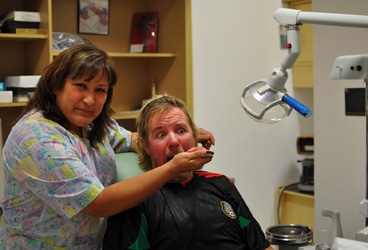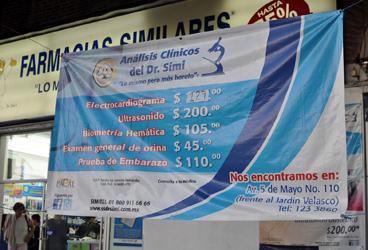
Mexico dentist
Back in La Paz a couple months ago, Frances woke one morning with slight swelling in one eye. We figured it was a sty that would clear up on its own. It got worse.
We don’t have a phone and we don’t have a car. We don’t have a primary care physician. We don’t have health insurance coverage in the way we used to. We didn’t have an appointment. I walked Frances down the dock and to a clinic we’d seen in town. She and I sat in chairs with other patients waiting to see a doctor. We didn’t check in with a receptionist or even take a number. The folks in chairs when we got there knew they would see the doctor before us, and folks who arrived after us knew their place in the queue.
When our turn came, we entered the doctor’s office down the hall, a scale behind us and in front of us a small woman sitting behind a small, basic wood desk. I began describing Frances’s problem when she stopped me to ask whether I would rather speak English; she went to medical school in the U.S.
She listened carefully, asked a couple questions, examined Frances and gave me a diagnosis and a prescription for antibiotic eye drops and cream. The doctor gave us her full attention and I felt I was free to spend another 15 minutes in there asking her questions if I liked.
I knew from the sign on the wall outside where we waited that the consultation fee is 40 pesos (about $3.07).
“Do I pay you?”
“You pay me.”

Another poster advertising a-la-carte services. In this case, EKG for under $10, an ultrasound for $15.30, complete blood work for $8, urinalysis for $3.25, and a pregnancy test for $8.50.
I found a 50-peso note in my pocket and handed it to her. She opened a drawer on her little wood desk, dropped the bill in, and fished out a 10-peso coin. We thanked her and left.
We filled the prescription at a local pharmacy (about $7.00 for both medications) and that day Frances jetted off to San Francisco, California with Windy.
Within 24 hours, the problem in Frances’s eyes had worsened, considerably.
After weighing limited options, Windy took Frances to a walk-in clinic for California’s uninsured. For the first fifteen minutes, Frances waited patiently while Windy completed the forms on her clipboard. She dutifully checked off that Frances is not pregnant, has never had syphilis, and doesn’t suffer migraines. The receptionist photocopied her driver’s license and they waited forty more minutes before a nurse called Frances to an examining room (they seemed efficient, but busy).
The nurse weighed and measured Frances. “The doctor will be right with you.” She said before closing the door and dropping Frances’s clean new file into a bin on the wall outside.
After examining Frances and seeing the medicines she was prescribed in Mexico, the doctor surmised that the antibiotic Frances was using was incorrect and she prescribed another. Cost: $200 (visit) + $35 (prescription).
Frances’s eyes did not improve.
Windy returned to the same clinic. This time the doctor referred Frances to a private practice ophthalmologist. The clinic called ahead and got Frances an appointment for the same day. Cost: $200
The ophthalmologist examined Frances and determined that she suffered from a viral condition that simply needed to run its course, one that was exacerbated by antibiotics. Cost: $275
Frances’s eyes improved quickly and she was soon back to normal.
I think the disparities in the cost of care and approach to care in the two countries are intertwined. In other words, the cost is higher because the approach is different. So what accounts for the difference in approach?
Because of the way the Mexican civil courts are structured, litigation there is rare*. It follows that Mexican doctors are not strangled by exorbitant premiums for malpractice insurance and every bit of CYA that goes with it, such as unnecessary interventions and overzealous, superfluous documentation. Too, there is a definite cultural distinction regarding how doctors are perceived. As in the U.S., doctors are at the high end of the income scale, but that income band is not as wide. The average doctor in Mexico can live very comfortably, but will earn less than a quarter of the income of her U.S. counterpart. The profession in Mexico is respected, but not exalted. When my mom was in a private hospital in Puerto Vallarta for surgery to repair her broken femur, I was caught off guard several times at the intimate, casual nature of the care. The white coat is not de rigueur; her surgeon often did his rounds in street clothes and the first time we met her anesthesiologist, the woman walked into the room looking no different than a woman in the grocery store, with her purse hanging from her arm. And like other small businesses in Mexico, a doctor’s practice is as likely to be run out of their home as any other location. For all of these reasons, Mexican health care systems can be easily pared down and adapted to meet the needs of even the very poor. I think these same factors are at play in other countries to varying extents.
Mexico has a nationalized health insurance program and some government-run hospitals, but the doctor Frances saw in Mexico is an employee of a private company. Had Frances not traveled when she did, we would have eventually wound up in the office of a private-practice ophthalmologist in La Paz to get the same viral diagnosis—at a cost likely ten or twenty times what we paid at the walk-in Mexican clinic, and still dirt cheap by U.S. standards.
Another cruiser wrote recently about his experience with Mexico’s medical care system. He got a colonoscopy ($300 for a state-of-the-art procedure, and a DVD to boot). Two observations he made highlight how disparate the two countries approaches are. “We left the Dr office with a bag containing two plastic bottles filled with my colon biopsy samples. So into a Taxi we went to drop them off at the lab. We will pick up our own lab results when they are ready and if everything looks good, we are done, no need to see the Dr again just for him to tell us what we can clearly read on the lab report…[and] it sure was a lot cheaper than using the Medical Currier lab service!” Then he wrote, “The test results won’t be kept in the office in case of a law suit for 20yrsor summarized and sent on to some masterminds at a Government run health care review board, but remain with ME, the paying patient.”
For a family out cruising, or trying to make the leap, health care considerations can be one of the biggest obstacles to overcome—especially if there is an existing, ongoing condition for which treatment is expensive and currently covered by an employer-based health insurance plan. But it is important to remember that care outside of the U.S. is significantly more affordable and readily attainable. This fact is highlighted by a restriction attached to our international, high-deductible, catastrophic health insurance plan: we are prohibited from spending longer than six months in the U.S.–and the U.S. is the only country in the world for which there is a restriction–during any policy period.
–MR
- In Mexican civil courts, the pressure is on to reach an agreement because both sides know that for civil trials, they must pay their own court costs and no special or punitive damages can be awarded. Mexican civil trials are not held before a jury, but judges alone review arguments in writing and render decisions. In Mexico, lawyers on both sides cannot be present when either party or witnesses are called in to make statements. Pretty radical and I’m not advocating this as a model for U.S. tort reform, but as an example of the way medical needs can be met affordably (as they are in much of the world) when legal impediments are absent.
_I__n our twenties, we traded our boat for a house and our freedom for careers. In our thirties, we slumbered through the American dream. In our forties, we woke and traded our house for a boat and our careers for freedom. And here we are. Follow along at _








